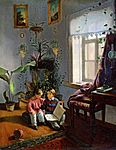Jan Chrucki
Jan Chrucki | |
|---|---|
 Ivan Khrutsky, self-portrait, 1883 | |
| Born | 8 February 1810 |
| Died | 26 January 1885 (aged 74) Zacharnicze, Russia |
| Nationality | Russian, Polish |
| Known for | Painter |
| Movement | Realism |
Ivan Fomich Khrutsky (Template:Lang-pl; Russian: Иван Фомич Хруцкий; Belarusian: Іван Хруцкі; 1810-1885) was a Russian painter of Belarusian descent known by his still lifes and portraits.
Biography
He was born into a Belarusian family descended from the nobility of Leliwa coat of arms in the village of Ulla, Vitebsk Governorate (located in modern Belarus). In 1827 Chrucki came to St. Petersburg and in 1830 entered the Imperial Academy of Arts.
His first known works are dated 1832. The paintings gradually gathered public and critical acclaim. Chrucki also worked as an interior designer, and became a popular amongst the wealthy home owners. In 1836 he was awarded the Major Silver medal of the Academy for his still-lifes. Chrucki also executed nice genre pictures and portraits. Old Woman Knitting a Sock, brought him the Minor Gold medal of the Academy. In 1839 he was awarded the title of the Academician.
After his father’s death in 1840 Chrucki left St. Petersburg forever and settled in the family estate Zacharnicze (Zakharenichi, Zacharniczy), Polotsk region. This period was one of commissioned religious art, mostly from Lithuania. Besides religious paintings he also worked on portraits, such as I.I. Glazunov's, Joseph Semashko's, Mikolaj Malinowski's and others. He died in his estate in Zacharnicze in 1885.
Selected paintings
-
In the Room
-
Portrait of historian and journalist Mikołaj Malinowski (1799-1865)
-
Still life with Mushrooms
Literature
- Kuznecow S. Malarz Jan Chrucki. Portret XIX-wiecznego 'artysty srednego'// Biuletyn historii sztuki. R. LX: 1998. nr.1-2. S.49-67.




